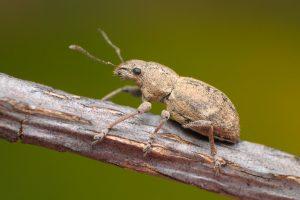Fuller rose beetle of the true weevils family has an extensive range occupying parts of North America, South America, Africa, Australia, and several Pacific islands. As the name suggests, it is a pest of rose trees, causing significant damage to them.

Size: 6 – 8.5 mm (0.23 – 0.33 inches)
Color: They have a brownish-grey body with white scales all over.
Other Characteristic Features: They have laterally positioned bulging eyes and a slightly curved snout pointed groundwards. Their wing covers remain fused; hence these beetles cannot fly.
They have a white body with black mandibles and yellowish head capsules. Fully grown larvae are about 10 – 12mm (0.39 – 0.47 inches). In fact, upon hatching, the larva gets into the soil and eats the roots for the next ten months. In its third instar, it goes on to create a smooth-walled cell for pupation.
The pupal stage lasts for about two months.
The cylindrical-shaped eggs appear yellowish, having a white sticky covering. The female beetle mostly places the eggs within crevices, cracks of barks, and leaves. They grow to a length of about 1mm (0.03 inches).
| Other names | Fuller rose weevil, Fuller’s rose weevil |
| Adult lifespan | 3 – 8 months |
| Duration of larval stage | 6 – 10 months |
| Distribution | North America, South America, Europe, South Africa, Australia, and Pacific Islands |
| Habitat | Forests, orchards, gardens, and places where their host plants grow |
| Common Predators | Assassin bugs, birds like praying mantises |
| Seasons active from | May – June; Late August – September |
| Host Plants | Rose, strawberry, peach, potato (primary hosts); apple, oriental persimmon, avocado, walnut, passion fruit, apricot, plum, oak (secondary hosts) |
| Diet of larvae and adults | Larvae: Roots Adults: New foliage, young shoots |
The adults chew the edges or the leaves making them appear notched and serrated, giving them a ragged look. In case of severe infestation, it can eat up the whole leaf keeping only the midribs left. The larva chews up the roots to the extent that it loses the capacity of absorbing water and nutrients properly. In case of heavy damage, the roots could die, or the pants may be exposed to fungal infection.
Image Source: live.staticflickr.com, idtools.org, ucanr.edu, pir.sa.gov.au, lh3.googleusercontent.com, agric.wa.gov.au
Fuller rose beetle of the true weevils family has an extensive range occupying parts of North America, South America, Africa, Australia, and several Pacific islands. As the name suggests, it is a pest of rose trees, causing significant damage to them.

Size: 6 – 8.5 mm (0.23 – 0.33 inches)
Color: They have a brownish-grey body with white scales all over.
Other Characteristic Features: They have laterally positioned bulging eyes and a slightly curved snout pointed groundwards. Their wing covers remain fused; hence these beetles cannot fly.
They have a white body with black mandibles and yellowish head capsules. Fully grown larvae are about 10 – 12mm (0.39 – 0.47 inches). In fact, upon hatching, the larva gets into the soil and eats the roots for the next ten months. In its third instar, it goes on to create a smooth-walled cell for pupation.
The pupal stage lasts for about two months.
The cylindrical-shaped eggs appear yellowish, having a white sticky covering. The female beetle mostly places the eggs within crevices, cracks of barks, and leaves. They grow to a length of about 1mm (0.03 inches).
| Other names | Fuller rose weevil, Fuller’s rose weevil |
| Adult lifespan | 3 – 8 months |
| Duration of larval stage | 6 – 10 months |
| Distribution | North America, South America, Europe, South Africa, Australia, and Pacific Islands |
| Habitat | Forests, orchards, gardens, and places where their host plants grow |
| Common Predators | Assassin bugs, birds like praying mantises |
| Seasons active from | May – June; Late August – September |
| Host Plants | Rose, strawberry, peach, potato (primary hosts); apple, oriental persimmon, avocado, walnut, passion fruit, apricot, plum, oak (secondary hosts) |
| Diet of larvae and adults | Larvae: Roots Adults: New foliage, young shoots |
The adults chew the edges or the leaves making them appear notched and serrated, giving them a ragged look. In case of severe infestation, it can eat up the whole leaf keeping only the midribs left. The larva chews up the roots to the extent that it loses the capacity of absorbing water and nutrients properly. In case of heavy damage, the roots could die, or the pants may be exposed to fungal infection.
Image Source: live.staticflickr.com, idtools.org, ucanr.edu, pir.sa.gov.au, lh3.googleusercontent.com, agric.wa.gov.au